Teaching your dog to use the pool safely protects everyone and makes swim time a whole lot more fun.
Plenty of dogs are curious about water, but let’s be honest—some are a bit nervous, and not every pup is born knowing how to swim. If you take the right steps, your dog will get comfortable around the pool without feeling pressured or stressed.
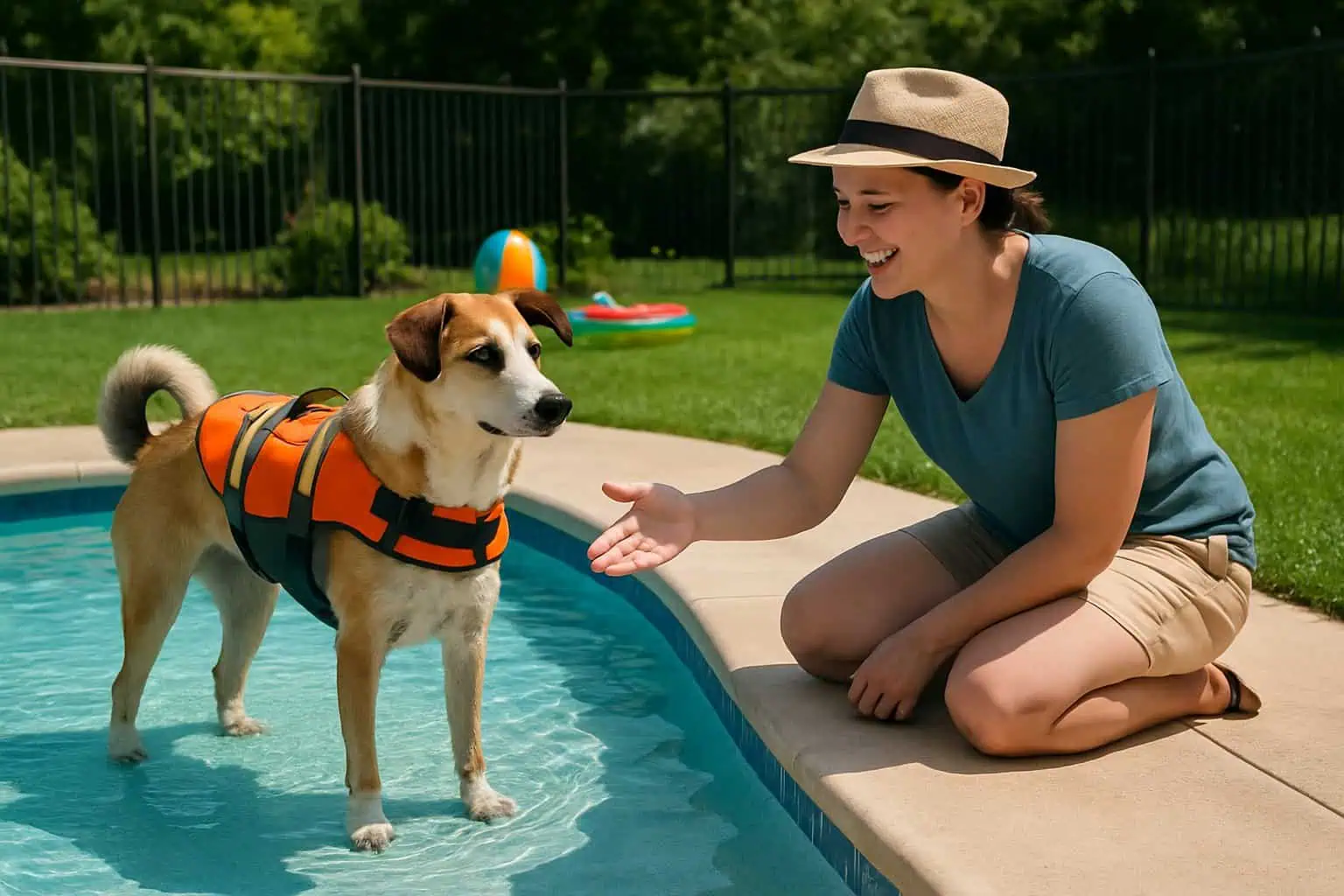
It’s all about baby steps, allowing your dog explore at their own pace, and rewarding progress. You’ll start spotting those little signs of fear, help with those first swims, and eventually set up a safe swimming routine.
With patience and a good attitude, most dogs can learn to love the water and cool off on hot days.
Understanding Pool Safety Measures for Dogs
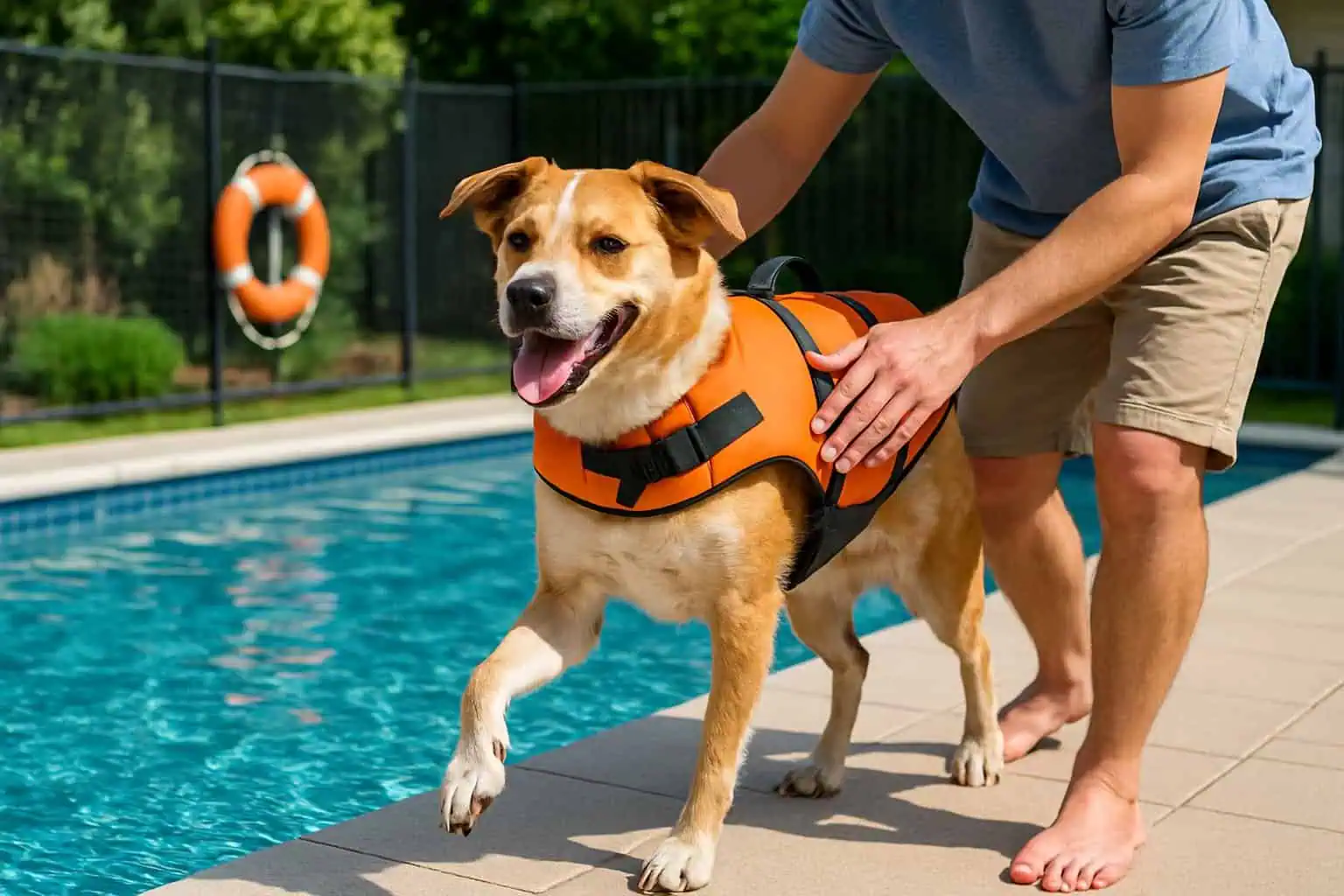
Pool safety isn’t just about teaching your dog to paddle. It’s making sure the area is free of hazards and your dog has the right gear for water play.
Recognizing Risks and Hazards
Dogs can slip or fall into the pool by mistake. Puppies, seniors, and dogs with health issues tire out faster or might struggle in the water. Some pool chemicals can irritate their skin or eyes.
If you leave a dog unattended, they might not find the way out. Not every dog knows where the steps are or how to use them. Even strong swimmers can get panicked if they can’t spot the exit.
Stay close when your dog is near the pool. Never leave them alone around water. Make sure there aren’t any toys, covers, or furniture by the edge that could trip them up or trap them.
Choosing Safe Pool Locations
Pick a pool spot that helps prevent accidents. Fence the pool completely so your dog can’t wander in when you’re not looking. The gate should lock securely.
Concrete and tile decks get slippery. Toss down some non-slip mats or go for a textured surface to help avoid falls. Clear any clutter and make sure your dog’s path in and out is easy.
Set up a dog ramp or wide steps for safe entry and exit. Mark the exits with bright colors or signs so your dog can spot them. Motion sensors or pool alarms can alert you if anything enters the water.
Importance of a Dog Life Vest
A dog life jacket gives extra buoyancy, making it easier for your dog to float—especially if they’re new to swimming or not a natural swimmer.
Pick a vest that fits snug but isn’t restrictive. Look for a handle on the back so you can grab and lift your dog out if needed. Bright colors or reflective straps help you spot your pup in the pool.
Unlike labrador retrievers, some breeds, like bulldogs and pugs, just aren’t built for swimming and really need a vest, even in shallow water. Keep an eye on the vest to make sure it’s secure and in good shape.
Preparing Your Dog for Pool Training
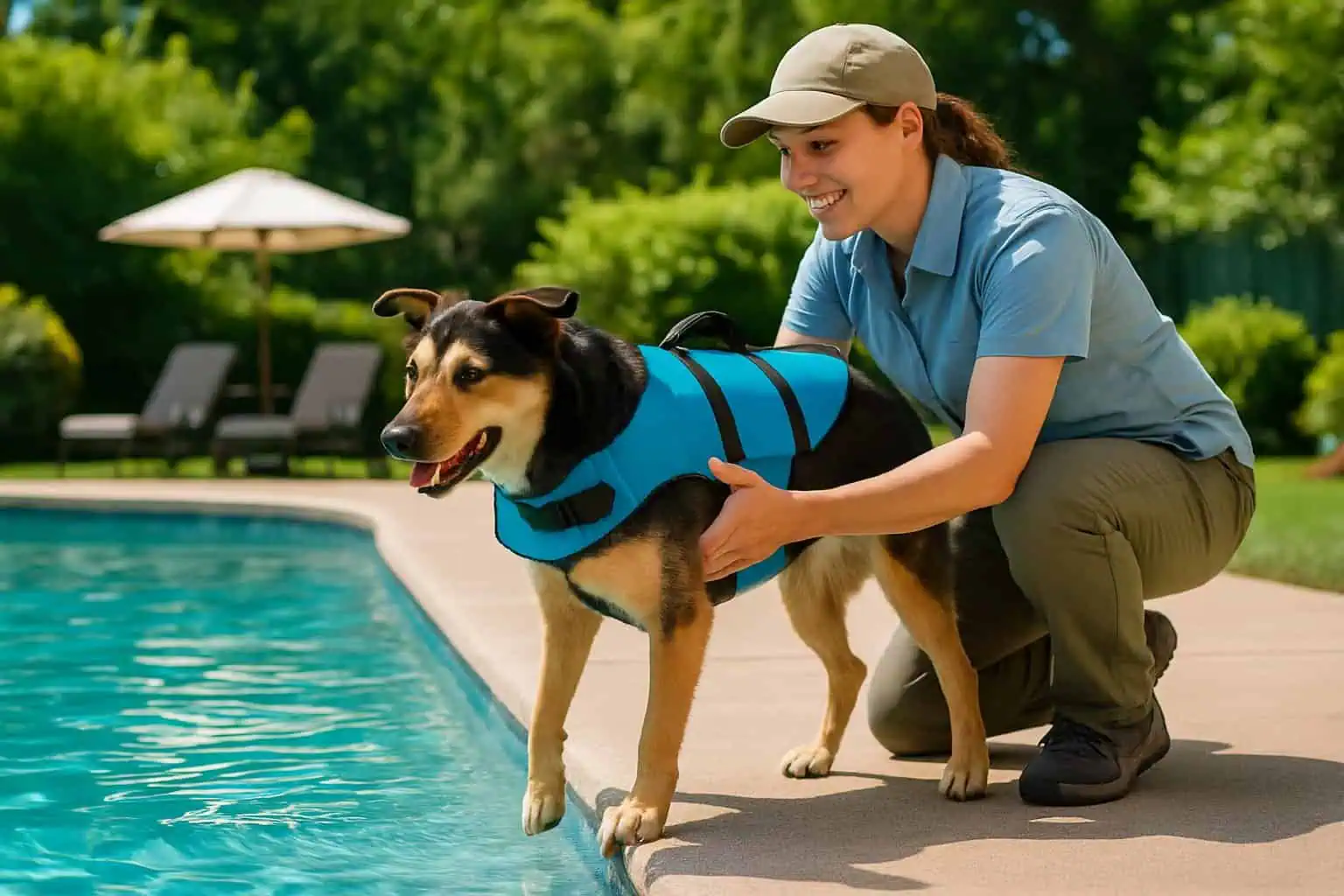
Safety and comfort come first when you’re introducing your dog to the pool. A gentle approach helps prevent fear and makes the whole process smoother.
Assessing Your Dog’s Swimming Ability
Every dog’s different. Some, like Labs and Spaniels, seem born for the water. Others—especially those with short legs or heavy builds—might need more help.
Watch how your dog reacts to water during baths or walks in the rain. If your pup avoids water or looks nervous, get ready to be extra patient. Notice things like hesitation, a tucked tail, or backing away.
Start in the shallow end and see how your dog does with paddling. Don’t assume all dogs can swim. If you’re not sure, ask your vet before diving into pool training.
Introducing Water Gradually
Let your dog check out the water slowly—no pressure. Gradual exposure builds confidence and sets up future pool sessions for success.
Start by ollowing your dog sniff around the pool. Next, encourage them to dip a paw or stand on the shallow steps. Praise and treats go a long way for calm behavior.
Gently splash a little water on their legs so they get used to the feeling. Move deeper step by step, and keep your tone relaxed. Never force your dog into the pool—it just makes things worse.
Selecting the Right Training Equipment
Good gear makes everything easier and safer. A dog life vest is a must for new swimmers or smaller dogs.
Choose a vest that fits well—not too tight, not too loose. Bright colors make your dog easier to spot, and handles help you lift them out.
Check out these dog life vests.
A non-slip ramp or sturdy pool steps make exits safer. Floating toys keep things fun and rewarding. Have fresh water and towels nearby to rinse off chlorine and dry your dog after a swim.
Step-by-Step Pool Training Methods
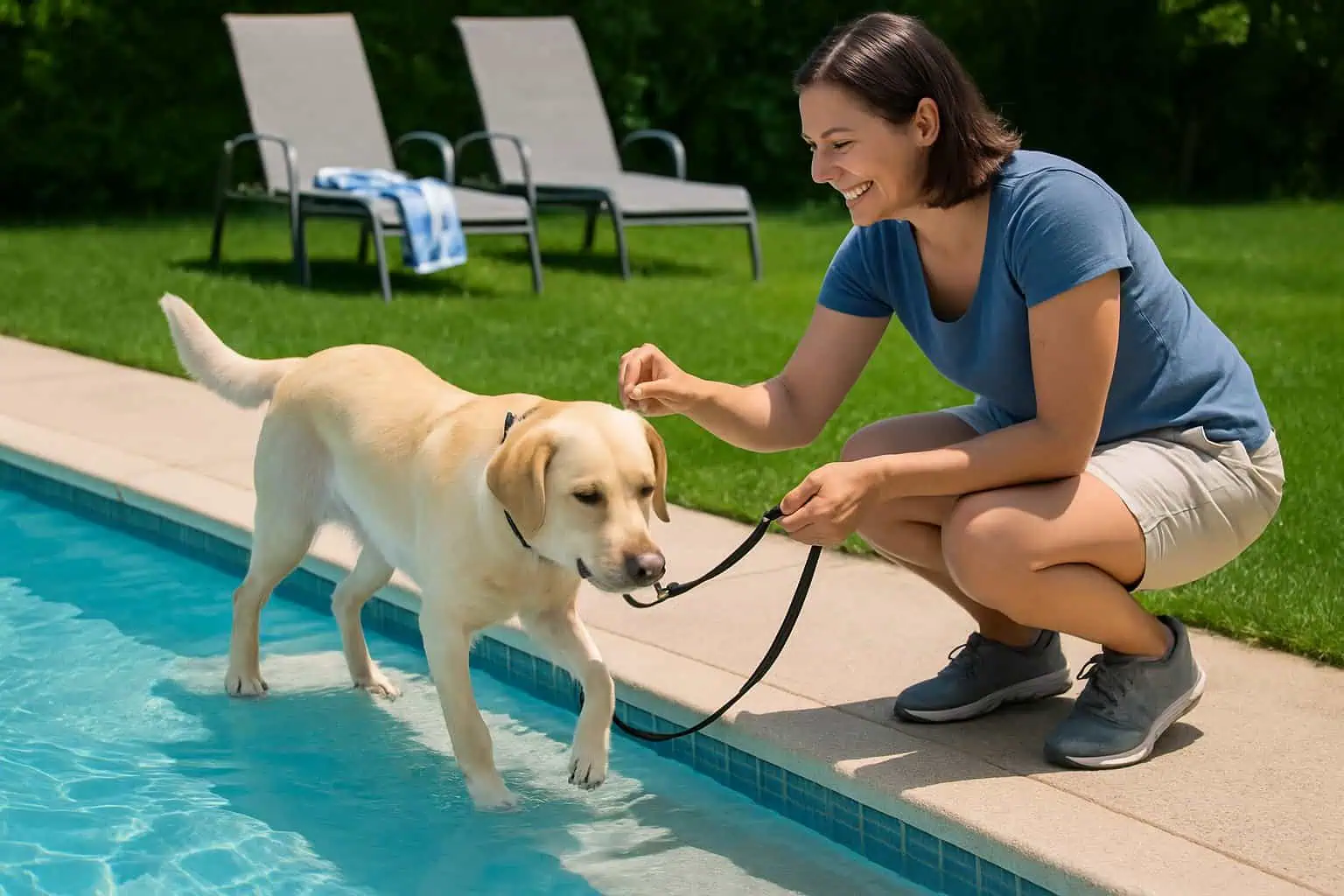
Dogs pick up pool skills best when you break training into small, manageable steps. If you keep things patient and clear, your dog will stay calm and safe around water.
Creating Positive Pool Associations
First, help your dog feel good about being near the pool. Bring their favorite toys, treats, or even a comfy blanket to the area. Let your dog sniff, explore, and just hang out.
Play gentle games by the pool, offer praise, and hand out small rewards. Keep things upbeat—don’t push your dog closer than they’re ready for. If you use treats and encouragement every time your dog approaches, you’ll build a positive reinforcement.
Move closer to the pool’s edge bit by bit. Don’t rush. Some dogs take a while to feel secure.
List: Helpful Items
- Soft treats
- Floating toys
- Comforting leash or harness
Teach A Dog Safe Pool Entry
When your dog’s relaxed by the pool, start teaching them how to enter the pool safely. Use a stepwise approach, beginning at the shallowest entry. If there are steps, encourage your dog to enter by putting one paw in, then two, on the first step.
Stay close and encourage progress with calm words and treats. Hold the leash or harness for support, especially if your dog’s new to this. Some pups like it better if you step in first.
Don’t push, shove, or pick up your dog unless you absolutely have to. If they seem scared, slow down and practice more at their pace. Always wrap up sessions on a positive note—let your dog leave the pool area when they want.
Tip: Short, frequent sessions, using positive reinforcement, beat long, stressful ones every time.
Teaching Your Dog How To Exit the Pool
Teaching your dog how to exit the water is just as important as showing them how to get in. Always show them where the steps or ramp are before you start swimming.
Lead your dog to the exit several times, using treats or a toy as a guide. Repeat until your dog can find and use the exit on their own. If they seem confused, lay a bright towel or mat by the step for a visual cue.
Keep the exits clear. Practice leaving from both shallow and deep ends if you can. That way, your dog knows they can always get out, wherever they are in the pool.
Establishing Swimming Pool Rules and Supervision

Keeping your dog safe around the pool means you need to supervise and set clear rules. Stay alert and give your dog straightforward guidance every time the pool’s in use.
Supervising All Pool Sessions
Supervision is key. Don’t leave your dog alone near or in the pool, even if they’re a strong swimmer.
Accidents happen fast. Your dog could get tired, struggle to exit, or panic if surprised. Someone should always watch during swim sessions. If you can, install a pool fence or pool cover to block unsupervised access.
Watch your dog’s body language. If you spot stress or exhaustion, it’s time for a break. Keep rescue items like a life ring or reach pole nearby.
List of supervision tips:
- Assign one person to watch pets during swim time
- Limit pool time for young, senior, or inexperienced dogs
- Check the water temperature before starting
Setting Boundaries and Commands
Training your dog on pool rules helps them understand what’s allowed. Use easy commands like “wait,” “leave it,” or “out” to direct them.
Show your dog where to enter and exit. Practice these routines each session. Try a non-slip mat or steps to mark the safe area.
Be clear and stick with your rules. Don’t let dogs run or jump around the pool unless you say so. Positive reinforcement—treats and praise—works wonders for good behavior.
Common pool commands:
| Command | Purpose |
|---|---|
| Wait | Stop at the edge of the pool |
| Exit | Leave the pool immediately |
| Stay | Remain in a safe area |
Addressing Common Dog Pool Behavior Issues
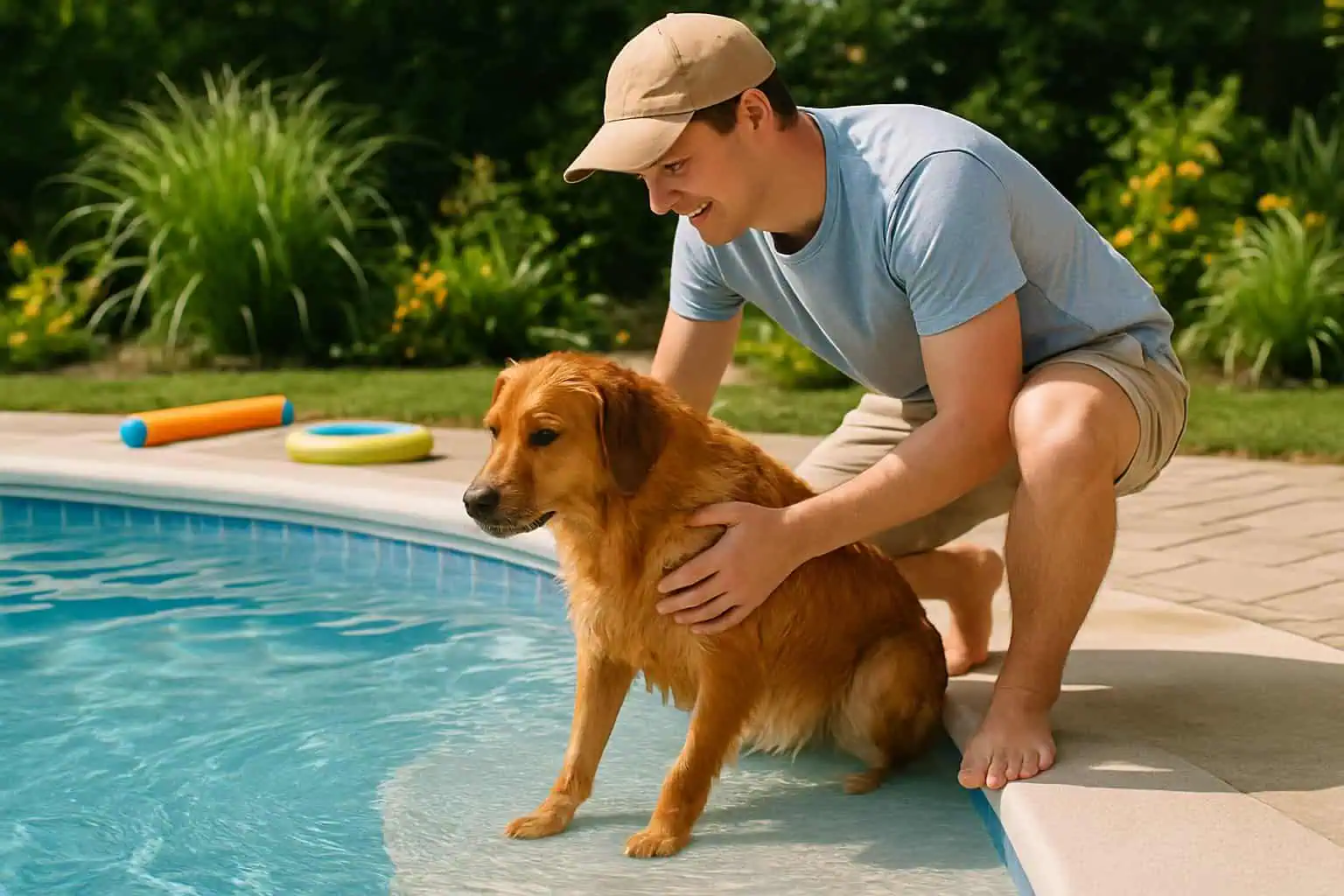
Some dogs are scared of water, while others get so hyped they’re hard to control. A calm, steady approach helps with both and encourages safer swimming.
Overcoming Fear of Water
Plenty of dogs get nervous around water. To help, introduce the pool slowly. Walk your dog around the pool on a leash—don’t force them in.
Guide your dog to the steps and let them dip their paws. Praise calm behavior. Toys and treats can make those first steps more fun.
Never push or toss a scared dog into the water. Patience is everything. A flotation vest can help your dog gain confidence as they learn to swim.
If your dog stays anxious, keep sessions short and positive. End on a high note with gentle encouragement. Sometimes it takes several tries before your dog becomes more comfortable.
Managing Excitement and Overstimulation
Some dogs get so excited near water that they bark, jump, or run wild by the pool. Too much excitement can lead to accidents or just chaos.
Use basic commands like “sit,” “wait,” or “come” before playtime. Reward calm behavior and take breaks to keep things from getting out of hand.
Keep training sessions simple—limit toys and people in the pool. A chill atmosphere helps your dog focus instead of getting overstimulated.
If your dog starts getting hyper, lead them to a quiet spot to calm down before heading back to the pool. Sticking to a routine helps your dog learn to enjoy the pool safely.
Pool Maintenance and Health Considerations for Dogs
Dogs in your backyard pool mean more fur and dirt in the water, plus some risks like algae exposure. You’ll want to keep your pool clean and safe for both people and pets.
Preventing Pool Water Contamination
Dogs shed fur and bring in debris, which can clog filters and dirty the water. Clean out skimmers and vacuum the pool often to handle hair and floating stuff.
To cut down on contamination:
- Rinse your dog before swimming to get rid of dirt and loose hair
- Trim nails to protect pool liners
- Use a pool cover when you’re not swimming
- Take bathroom breaks before pool time
Test and balance your pool chemicals regularly. Chlorine and pH levels can shift fast with dogs swimming. Chlorine kills bacteria but needs to stay at safe levels to avoid irritating your dog’s skin or eyes. If your pool gets daily dog visits, check water quality several times a week.
Understanding the Risks of Blue-Green Algae
Blue-green algae—technically cyanobacteria—can cause real trouble if it shows up in or around pools. These little organisms love warm, still water and can churn out toxins that might seriously harm or even kill dogs if they swallow any.
If you notice the water in the pool turning green, looking cloudy, or sporting a weird film on the surface, that’s a red flag. Keep pets away. Pools with decent chemical balance and filtration almost never have this problem, but ponds and lakes nearby? Whole different story. Dogs exposed to blue-green algae might start vomiting, drooling, having diarrhea, or even seizures. If you spot any of that, don’t wait—get to a vet right away.
Before letting your dog near any water, especially in the heat, take a good look for algae. Keep the pool covered and stay on top of cleaning to keep things safe.
Monitoring Your Dog’s Health After Swimming
After your dog’s done swimming, keep an eye out for any irritation or weird behavior. Red eyes, itchy skin, or ear trouble can pop up from pool chemicals or bacteria.
Make sure to dry your dog’s ears and fur really well after a swim—cuts down the risk of infection. Dogs who swim a lot sometimes get sensitive skin, so a gentle dog shampoo after a dip can help wash away any lingering stuff.
Read Is it safe for a dog to swim in a chlorinated pool.
If your dog guzzles too much pool water, watch for an upset stomach or a lot of vomiting. Should that happen, it’s probably time to call the vet. Swimming’s usually safe for most dogs, but keeping up with hygiene and regular checkups just makes sense.
Advanced Water Safety Tips and Ongoing Practice
Pool safety isn’t just about teaching your dog to paddle around. You need routines and the right gear to keep pets safe, even when nobody’s looking.
Using Barriers and Covers
Honestly, putting up barriers is one of the best moves for pool safety. Fences and gates made for pools stop dogs from sneaking in when no one’s there to watch. Mesh or metal barriers need to be strong and tall enough so dogs can’t jump over or wriggle through.
Pool covers should fit snugly over the water. Go for solid covers that can actually hold a dog’s weight—those prevent accidental falls. Mesh covers? Unless they’re rated as safety covers, they’re risky; small animals can slip right under.
Always double-check that gates latch and covers are secure after you’re done. If you’ve got kids around, keep latches locked and out of reach. For a little extra peace of mind, you might want to install a pool alarm that goes off if something hits the water. It could give you those extra seconds you need in an emergency.
Year-Round Pool Safety Precautions
Pool safety isn’t just a summer thing—it matters all year. In fall and winter, scoop out leaves and debris from the pool, since those can trip up or confuse your dog. Double-check that pool covers still fit snugly and haven’t gotten loose during colder weather.
Keep pool chemicals at safe levels and stash them in locked containers, well out of your dog’s reach. If you let your dog swim when it’s chilly, don’t let them stay in too long. Nobody wants a shivering pup.
Practice how your dog gets in and out of the pool throughout the year. Mark the pool steps with some brightly colored tape or mats so they stand out. Walk your dog through the entry and exit process a few times, especially if you’ve changed anything around the pool or yard. It might seem repetitive, but it really helps your dog remember the safe way in and out.

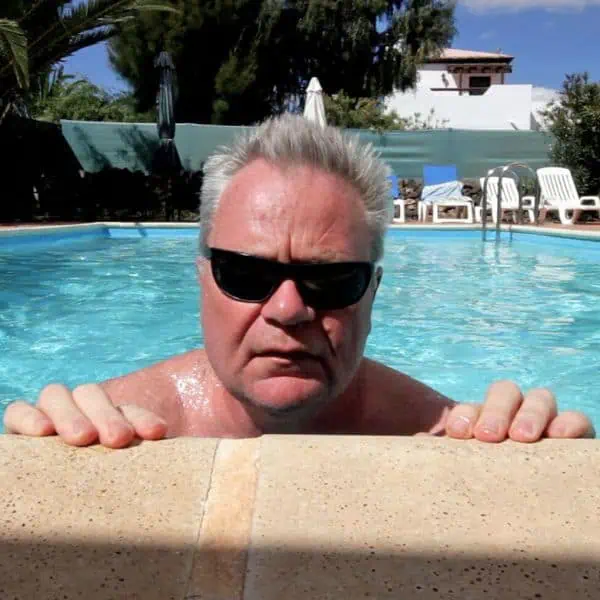


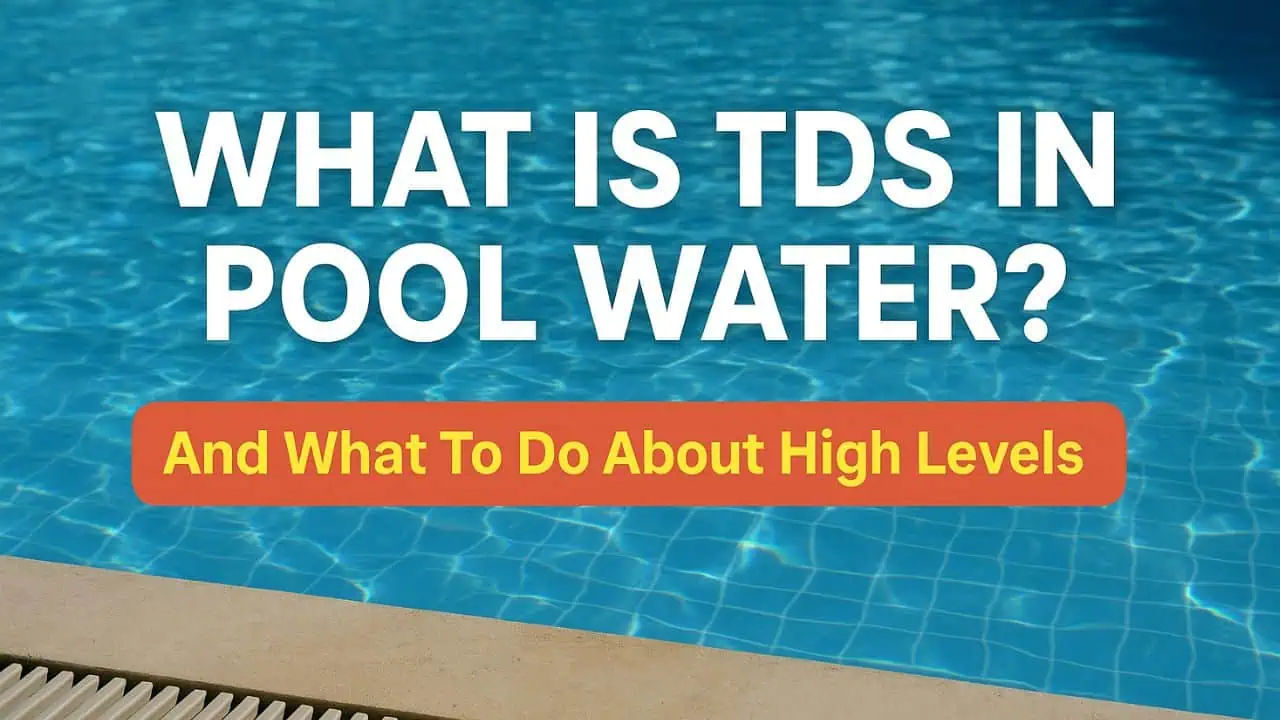
Leave a Reply